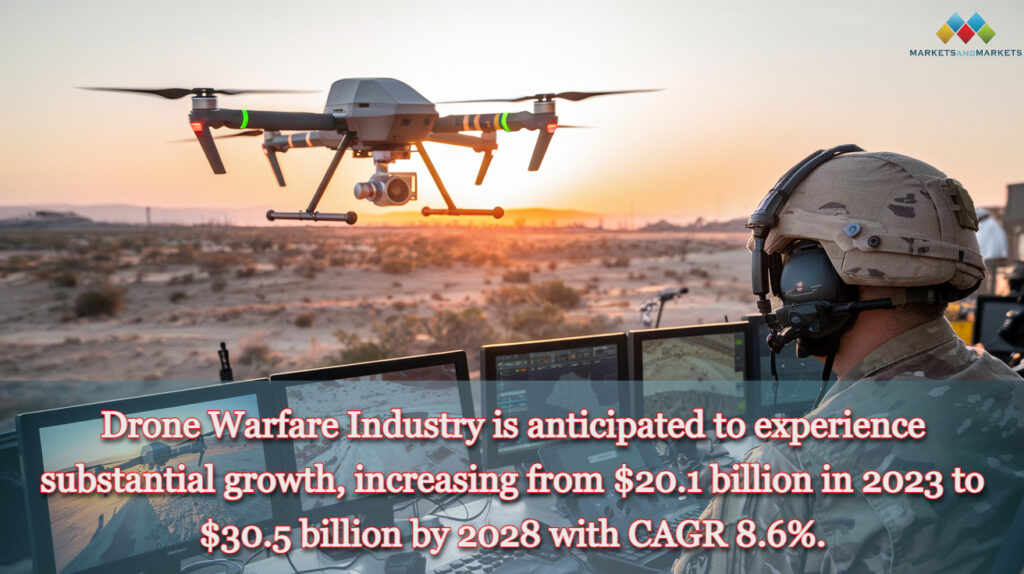The Drone Warfare Industry has seen rapid growth, becoming an essential component in modern defense strategies worldwide. Unmanned Aerial Vehicles (UAVs) have shifted from niche tools to indispensable assets in both military and non-military applications. The global drone warfare market is expected to grow substantially, driven by technological advancements, military modernization, and evolving combat strategies.
The drone warfare market size is poised to experience growth, advancing from USD 20.1 billion in 2023 to reach USD 30.5 billion by 2028, with a Compound Annual Growth Rate (CAGR) of 8.6% during the period from 2023 to 2028. Drones used in warfare can operate autonomously, be controlled remotely, or use a combination of both methods. These unmanned aerial vehicles (UAVs) are equipped with sensors, electronic receivers, transmitters, and offensive weaponry.

Download PDF Brochure @ https://www.marketsandmarkets.com/pdfdownloadNew.asp?id=117992027
Key Market Drivers
- Technological Advancements:
- Innovations in Artificial Intelligence (AI), machine learning, and sensor technologies have revolutionized drone warfare. These advancements allow drones to autonomously conduct complex operations such as surveillance, target identification, and precision strikes with minimal human intervention. AI-driven drones can analyze data in real-time, enhancing their effectiveness on the battlefield.
- Increased Defense Spending:
- Growing military budgets, especially in major powers like the United States, China, and Russia, are driving the expansion of drone fleets. Governments are investing heavily in UAV technology to modernize their military capabilities and gain a strategic advantage in conflict zones.
- Cost-Effectiveness:
- Compared to traditional manned aircraft, drones offer a cost-effective solution for combat operations. They reduce the need for human pilots in high-risk environments, cutting down operational costs while minimizing the risk of casualties.
- Global Conflicts and Threats:
- Rising geopolitical tensions, cross-border conflicts, and terrorist threats are fueling the demand for advanced UAV systems. Drones are being used for border surveillance, counter-terrorism operations, and maritime patrolling to prevent incursions and neutralize threats in real-time.
- Non-Military Applications:
- Beyond warfare, drones are increasingly being adopted for disaster response, environmental monitoring, humanitarian aid, and border control. The versatility of UAVs makes them invaluable in civilian applications, broadening the market beyond military use.
Major Applications of Drone Warfare
- Surveillance and Reconnaissance:
- Drones are widely used for real-time intelligence gathering and surveillance, providing military forces with up-to-the-minute data on enemy positions, movements, and terrain. UAVs can cover large areas and operate in hazardous environments where manned aircraft cannot.
- Combat and Precision Strikes:
- Armed UAVs, such as combat drones, are deployed for precision strikes against high-value targets. These drones can engage in combat missions without the need for a human pilot, making them an essential tool for counter-insurgency operations and covert missions.
- Logistics and Supply Delivery:
- Drones are also utilized for logistical support, delivering critical supplies such as ammunition, medical aid, and food to troops in remote or dangerous areas. This capability reduces dependency on traditional transport methods, which may be slow or vulnerable in conflict zones.
- Electronic Warfare and Jamming:
- Some UAVs are equipped with electronic warfare systems that can disrupt enemy communications and radar systems, providing a strategic advantage in combat by impairing the adversary’s ability to respond effectively.
Key Challenges in the Drone Warfare Industry
- Ethical and Legal Issues:
- The use of armed drones in warfare has sparked significant debate over the ethics of autonomous killing machines. The lack of direct human oversight in some UAV operations raises concerns about accountability, civilian casualties, and the broader moral implications of drone warfare.
- Cybersecurity Risks:
- As drones become more reliant on digital systems and networks, they are vulnerable to cyber-attacks. Hacking or jamming a drone’s communication system could lead to mission failures, data breaches, or the repurposing of drones by enemy forces.
- Regulatory Hurdles:
- International and domestic regulations on UAV usage can hinder the expansion and deployment of drone fleets. Differences in legal frameworks between countries complicate the use of drones in cross-border conflicts and military alliances.
- Public Perception and Opposition:
- Public opposition to drone warfare is growing, especially with concerns over the loss of civilian lives in drone strikes. The political and societal pushback could influence regulations and defense policies, limiting the scope of UAV deployment in future military operations.
Ask for Sample Report @ https://www.marketsandmarkets.com/requestsampleNew.asp?id=117992027
Future Outlook
The future of drone warfare is expected to be shaped by continued innovation in autonomous technologies, AI, and real-time data analytics. As defense forces increasingly rely on UAVs to enhance operational efficiency, the demand for drones in both military and civilian applications will continue to grow. Despite challenges related to ethics and cybersecurity, the drone warfare industry remains a key driver of modern warfare and national security strategies.